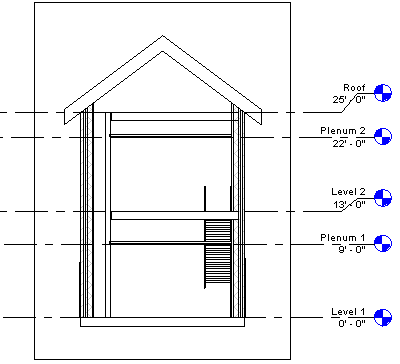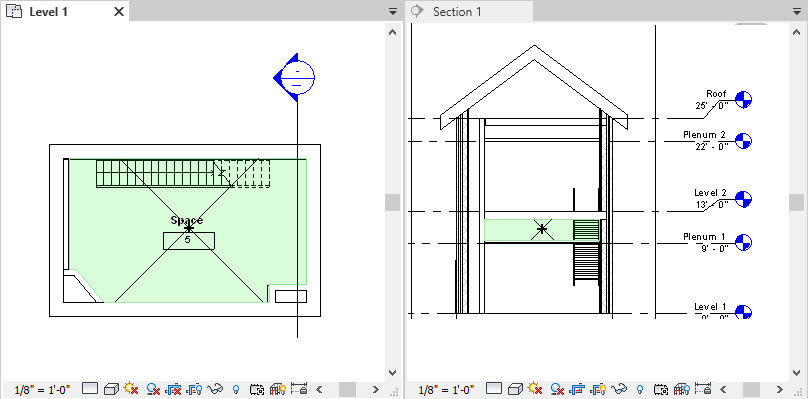This method places a space where its volume is constrained from a plenum level up to the next level above. You use this topic when placing spaces for plenums.
Open a floor plan.
You only use this floor plan to create a section. Next, you create a section view to create plenum levels and to verify the space vertically.
Create plenum levels
- If the project contains levels that are located at the ceiling height, select these levels, and in the Type selector, select Level : Plenum.
This changes these standard levels to the plenum levels.
Note: If you change the level type, you need to create new floor plan views based on the plenum levels. See Create a plan view. You can delete the old floor plan views in the Project Browser. - If the project contains plenum levels, you can skip this section.
However, you need to confirm in the Project Browser that floor plan views based on the plenum levels exist. See the note above, if you need to create the floor plan views based on plenum levels.
- If the project does not contain levels at the ceiling height, click Architecture tab
 Datum panel
Datum panel
 (Level).
(Level).
- In the Type Selector, select Level : Plenum.
- On the Options Bar, do the following:
- Verify that Make Plan view is selected.
- Click Plan View Types, and in the Plan View Types dialog, select only Floor Plan, and click OK.
This creates a new floor plan view based on the plenum level that you create. You need this floor plan view to place spaces in the plenum areas.
- For Offset, verify that 0' 0" (0.00 mm) is specified.
- Add plenum levels at the height of the ceiling.

- Click Modify.
- In the Project Browser, under the working discipline, double-click ???
 Floor Plans, right-click a new plenum floor plan view, and click Properties.
Floor Plans, right-click a new plenum floor plan view, and click Properties.
- On the Properties palette, specify the Sub-Discipline for the view.
This lists the new plenum floor plan view under its sub-discipline in the Project Browser.
You use plenum levels when placing spaces in areas that contain ceilings. Plenum levels are special levels that allow you to place spaces in the plenum areas above the ceiling by using a floor plan view based on the plenum level. You must place spaces in all plenum areas in order to perform an accurate heating and cooling loads analysis.
Specify view properties and activate spaces visibility
- In the Project Browser, double-click the floor plan view that is associated with the plenum level.
This view contains the plenum areas in which you need to place spaces.
- Close all views, except the section view and the plenum level floor plan view, and type
w t on the keyboard to tile the 2 views.
You can also click View tab
 Windows panel
Windows panel
 (Tile Views).
(Tile Views).
- Right-click in the floor plan view, and click Properties.
- On the Properties palette, under Extents, click Edit for View Range.
- In the View Range dialog, do the following:
- For Top, select the Level Above, and enter 0' 0" (0.00 mm) for Offset.
- For Cut plane, verify that the Associated Level is selected, and enter 0' 6" (150 mm) for Offset.
- For Bottom, verify that the Associated level is selected, and that a 0' 0" (0.00 mm) Offset is specified.
- For View Depth Level, verify that the Associated level is selected, and that a 0' 0" (0.00 mm) Offset is specified.
- Click OK.
This defines the view range so that the plenum spaces display in the floor plan view. Next, you specify the visibility for the section view.
- Click in the section view to make it active.
- Type v g on the keyboard.
- On the Model Categories tab of the Visibility Graphics dialog, scroll down to Spaces.
- Expand Spaces, select Interior and Reference (if you want to display reference crosshairs), and click OK.
- Repeat to make spaces visible in the floor plan view.
Place a space
- With the floor plan view active, click Analyze tab
 Spaces and Zones panel
Spaces and Zones panel
 (Space).
Note: You may need to load space tags in the project, if they are not already loaded.
(Space).
Note: You may need to load space tags in the project, if they are not already loaded. - On the Options Bar, do the following:
- For Upper Limit, specify the level above the level of the space.
- For Offset, enter
0' 0" (0.00 mm).
These 2 options specify the vertical extent or height of the space.
Note: If the upper limit and offset are specified to the level above, the vertical boundary of the space will snap to the floor above, even though the upper limit is higher than the floor. This is because with the Areas and Volumes option selected (default setting), the vertical boundary of the space will snap to room-bounding components, such as floors. The volume of the space will be calculated up to the room-bounding component. The Areas and Volumes option is located on the Architect tab Room & Area panel drop-down
Room & Area panel drop-down Area and Volume Computations.
Area and Volume Computations.
- In the Space box, either verify that New is selected if placing a new space, or select an unplaced space from the list to place it.
- Tag on placement: Places a space tag upon placement of the space.
Tag on placement is selected by default. If Tag on placement is selected, you can select the tag type from the Type Selector.
- Tag location box: specifies either Horizontal, Vertical, or Model as the space tag location.
Applicable only if Tag on placement is selected.
- Leader: Creates a leader line for the space tag.
Applicable only if Tag on placement is selected.
- Show Bounding Elements: Highlights the room-bounding elements in the building model for immediate recognition.
Select the following options as needed:
- In the floor plan view, move the cursor over a plenum area and click to place a space.
Note: Spaces can only be placed in floor plan views.
- Click Modify.
- Select the space.
- On the Properties palette, under Energy Analysis, clear Occupiable.
This defines the space as unoccupied.
Note: If you place a space in an area that contains a room, the Occupiable parameter is automatically selected. This defines the space as occupied. If the area does not contain a room, the Occupiable parameter is automatically cleared. This defines the space as unoccupied. You can always redefine the space by selecting or clearing this parameter. The Occupiable parameter affects the Systems Analysis. - In the section view, verify that the shaded area representing the volume of the space is constrained from the plenum level to the floor above, and that unshaded areas (caused by such things as cavities or shafts) do not exist. This provides for a more accurate volume calculation.

- If the space is not constrained as specified, in the section view, verify that the upper limit of the space is specified to the level above, and
redefine the space vertically, if necessary.
You must also resolve all unshaded areas.